Wheat 2013 NVT trial result
Author: Peter Burgess | Date: 29 Apr 2014
Key Messages
Mace continues to increase in acreage and occupied over 53% of WA sowings in 2013. Analysis of NVT 2013 data indicates the following:
- Magenta equalled the yield of Mace across WA in a long season, long cool rain fed finish to the season
- Emu Rock failed to out yield Mace even at the lower yielding sites,
- Corack out yielded Mace in Agzones 2 and 4,
- Following on from 2012 variety performance, Cobra once again performed best at high yielding sites. Cobra performed poorly on alkaline soils.
- With limited knowledge and experience, Trojan looks to be a possible alternative in the Yitpi growing areas for early sowing and a stem rust resistant alternative of Magenta maturity
- Harper is another possible Yitpi replacement, close to Yitpi in maturity, however potential screenings and a minimal yield advantage may be its limitation.
Background
The 2013 season in WA was typified by a perfect start to sowing with much of the state starting with a full soil moisture profile and follow up rains during crop establishment. The states crop was established in a very short time frame with a generally excellent germination and rapid initial growth due to the warm soils. The exceptionally dry June – Early July put a dampener on season expectations. When the rains started in July and did not stop until October the crops recovered and were able to go through flowering and grain fill under ideal conditions. The absence of any widespread frost events and the cool wet conditions were major factors contributing to a record crop. Leaf diseases were prevalent in many regionally specific barley and wheat crops, however with many growers and agronomists understanding the importance of spray timing and application rates, disease impact on yield was limited. The number of hectares sown to Mace continues to escalate.
Two new varieties were released out of the NVT in 2013, the APW variety Harper (Intergrain) and Trojan (LongReach) that is waiting on a final classification in WA but is currently classified as APW in the eastern states. Both varieties are later maturing than Mace and are susceptible to yellow leaf spot (YLS) although slightly better than Yitpi.
Aims
The aim of this study was to examine the performance in WA NVTs of varieties that would complement or provide superior yield and quality alternatives to the now benchmark variety Mace and the long serving and effervescent varieties, Yitpi and Calingiri.
Method
Yield data, Zadoks scores and site details including location, sowing date, and soil pH in the surface soil and at depth, were downloaded from the NVT database for the year 2013 from the website:
Predicted variety mean yield from each trial was plotted against the yield of Mace for each of the new and recently released varieties and linear regressions fitted. The year’s data was collated on a spreadsheet and sorted by Agzone (Figure 1) and subsoil pH to look for any specific adaptation of any of the newer varieties compared to Yitpi or Mace.
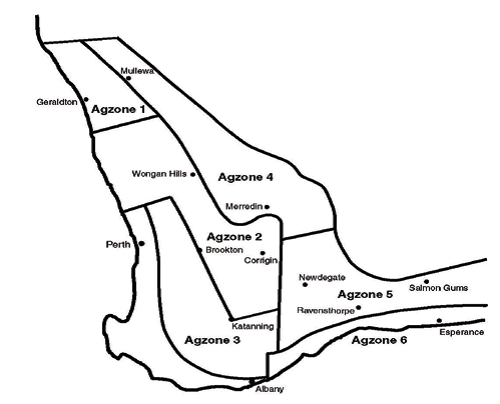
Results
Zadoks scores that were taken in the range Z45 to Z70 were summarised in order to determine the maturity of the new releases relative to Mace and Yitpi (Table 1).
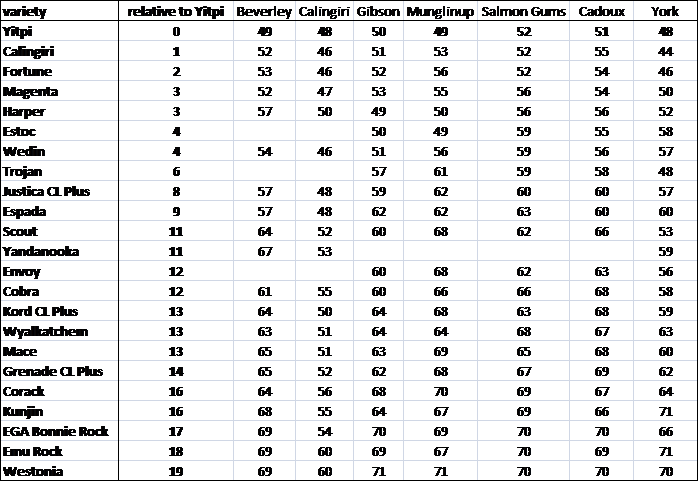
This showed that Trojan is mid way between Mace and Yitpi in maturity, making it very similar to Magenta. Harper was later and best described as mid way between Trojan/Magenta and Yitpi. The return to good growing conditions begged the question as to whether it would suite the later maturing Magenta more than the drier years that preceded 2013. The summary of yields of Magenta relative to Mace (Figure 2) is taken from Kevin Young’s paper at the 2012 Crop Updates
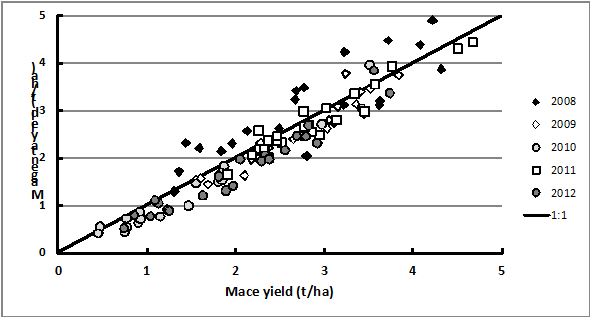
When Magenta is compared directly to Mace it is clear that in all years other than 2008 its yield was not competitive with Mace (Figure 2.) other than in isolated cases. A similar comparison for Magenta and Mace is shown in Figure 3 for the year 2013.
An increase in the severity of YLS than tends to accompany wet years may be the reason for Magenta occasionally out yielding Mace in these Agzones. The long term Met data (Table 2) indicates that Magenta is behind Mace for yield unless the growing conditions are above average.
Corack bounced back from a very erratic yield performance in 2012 to once again out yield Mace in Agzones 2 and 4 (Table 2 and Figure 4)
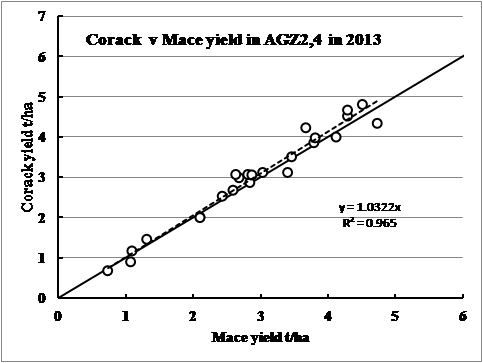
Cobra showed a similar trend to previous years with its best performance relative to Mace being at the highest yielding sites (Figure 5).
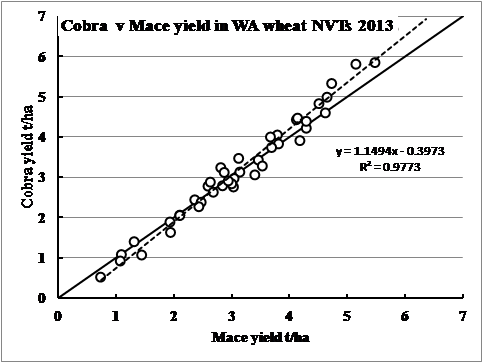
There was no relationship between Cobra’s yield advantage and subsoil pH evident in the 2013 data. The performance of the later maturing lines relative to Yitpi is presented in the long term Met summary (Table 3).

Of the newly released varieties the yield of Trojan was the most promising relative to Yitpi (Figure 6.)
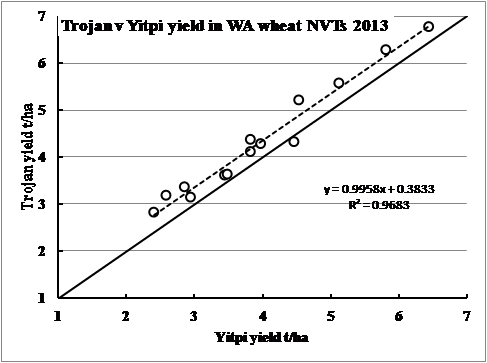
The long term met analysis shows that the yield of the noodle variety Fortune has been on par with Calingiri (Table 1.).

A similar trend is seen in the 2013 data as a stand alone (Figure 7).

The season had generally favourable spring rains so screenings levels were good at most sites. Of the newer varieties the one that may experience a problem with screenings appears to be Harper (Figure 8.)
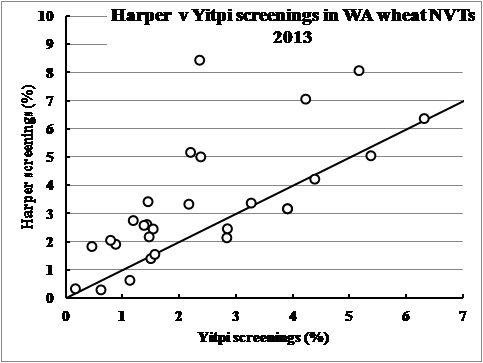
Conclusion
Mace continues to be a solid benchmark for yield in WA even in a season that would be expected to favour the longer season varieties. Yitpi has remained a popular choice for a late maturing line in some regions (particularly frost risk areas). There may now be viable higher yielding alternatives if the rusts become a problem:
- Magenta: 2013 was a year to suit Magenta and was as good a performer as Mace, edging ahead slightly at top end yields. 2013 does not occur frequently enough.
- Corack: Shows an ability to handle terminal drought and maximise yield potential should the season extend. Not suitable for areas of high blackpoint frequency.
- Cobra (AH) has improved YLS resistance and has tended to out-yield Mace at sites where yields are above 3t/ha. Lower grain weight more common in poor finishing seasons and lower yielding sites
- Trojan is a later (Magenta maturity) variety that may find a niche in WA.
Fortune continues to produce yields comparable to Calingiri but is unlikely to replace Calingiri.
- Wyalkatchem has been replaced as the benchmark after many productive years at the top of the tree
References
Wilson, I.R. 1984. Soil testing for acidity. Journal of Agriculture Western Australia 25: 121-122.
Key words
Wheat, varieties, National Variety Trials, grain yield
Acknowledgments
The author thanks the GRDC for funding the National Variety Testing project.
Grower Co-operators for providing trial sites
Grower Groups for providing research focus sites for the NVT
Kevin Young for his assistance in producing this paper
Kalyx Staff for planning and implementing the WA NVT program
GRDC project No.: KAL00003
Paper reviewed by: Kevin Young, DAFWA
Was this page helpful?
YOUR FEEDBACK


